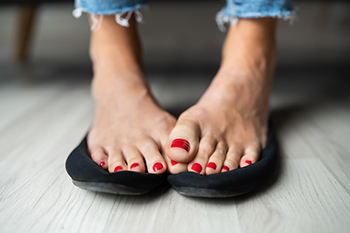Blog
Items filtered by date: March 2022
How to Take Care of Your Feet When You Have Diabetes
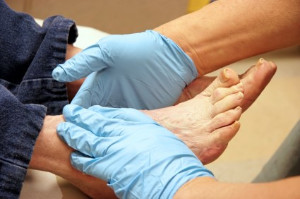 Diabetes can affect foot health and cause peripheral neuropathy, a condition where the central nervous system is damaged and signals from the brain to one’s feet do not work properly. This can cause inflammation and lead to numbness, tingling, and increased sensitivity in the feet, as well as more severe problems like foot ulcers and infections. Changes in lifestyle and diet can help keep blood sugar and weight in a target range that will help prevent nerve damage and neuropathy. Following diabetic food guidelines and eating at regular intervals are key to controlling diabetes and side effects like peripheral neuropathy from developing. It is also important to check your feet frequently to look for cuts, swelling, or other abnormalities. Having your feet checked regularly by a podiatrist when you have diabetes can help you stay on top of your foot health and prevent more serious complications from developing.
Diabetes can affect foot health and cause peripheral neuropathy, a condition where the central nervous system is damaged and signals from the brain to one’s feet do not work properly. This can cause inflammation and lead to numbness, tingling, and increased sensitivity in the feet, as well as more severe problems like foot ulcers and infections. Changes in lifestyle and diet can help keep blood sugar and weight in a target range that will help prevent nerve damage and neuropathy. Following diabetic food guidelines and eating at regular intervals are key to controlling diabetes and side effects like peripheral neuropathy from developing. It is also important to check your feet frequently to look for cuts, swelling, or other abnormalities. Having your feet checked regularly by a podiatrist when you have diabetes can help you stay on top of your foot health and prevent more serious complications from developing.
Diabetic foot care is important in preventing foot ailments such as ulcers. If you are suffering from diabetes or have any other concerns about your feet, contact one of our doctors from Favor Foot Ankle Leg & Wound Center. Our doctors can provide the care you need to keep you pain-free and on your feet.
Diabetic Foot Care
Diabetes affects millions of people every year. The condition can damage blood vessels in many parts of the body, especially the feet. Because of this, taking care of your feet is essential if you have diabetes, and having a podiatrist help monitor your foot health is highly recommended.
The Importance of Caring for Your Feet
- Routinely inspect your feet for bruises or sores.
- Wear socks that fit your feet comfortably.
- Wear comfortable shoes that provide adequate support.
Patients with diabetes should have their doctor monitor their blood levels, as blood sugar levels play such a huge role in diabetic care. Monitoring these levels on a regular basis is highly advised.
It is always best to inform your healthcare professional of any concerns you may have regarding your feet, especially for diabetic patients. Early treatment and routine foot examinations are keys to maintaining proper health, especially because severe complications can arise if proper treatment is not applied.
If you have any questions please feel free to contact our office located in South Amboy, NJ . We offer the newest diagnostic and treatment technologies for all your foot and ankle needs.
Excessively Sweaty, Smelly Feet
Not all sweaty feet are odorous. Sweaty feet become smelly when bacteria break down sweat that is unable to evaporate by wearing shoes that are too tight or unbreathable, practicing poor hygiene, or wearing socks that do not draw sweat away from skin. It is normal for feet to be sweaty occasionally due to heat, strenuous exercise, and the type of shoes we wear, among other things. Sweat is usually the body’s way of regulating its temperature. However, when sweating is not caused by these common factors and is excessive or persistent, hyperhidrosis (excessive sweating) may be the culprit. Hyperhidrosis is either generalized (affects the whole body) or focal and it typically affects the hands, armpits, groin, or—in the case of palmoplantar hyperhidrosis—the feet. You may have palmoplantar hyperhidrosis if you sweat through your socks frequently, slip around in your shoes, or if your feet look wet, or white. Consult with a podiatrist if you believe your feet sweat excessively. They may treat your hyperhidrosis with prescription topical medications and antiperspirants, Botox injections, or by disabling the sweat glands in your feet temporarily using a gentle electrical current through water.
If you are suffering from hyperhidrosis contact one of our doctors of Favor Foot Ankle Leg & Wound Center. Our doctors can provide the care you need to attend to all of your foot and ankle needs.
Hyperhidrosis of the Feet
Hyperhidrosis is a rare disorder that can cause people to have excessive sweating of their feet. This can usually occur all on its own without rigorous activity involved. People who suffer from hyperhidrosis may also experience sweaty palms.
Although it is said that sweating is a healthy process meant to cool down the body temperature and to maintain a proper internal temperature, hyperhidrosis may prove to be a huge hindrance on a person’s everyday life.
Plantar hyperhidrosis is considered to be the main form of hyperhidrosis. Secondary hyperhidrosis can refer to sweating that occurs in areas other than the feet or hands and armpits. Often this may be a sign of it being related to another medical condition such as menopause, hyperthyroidism and even Parkinson’s disease.
In order to alleviate this condition, it is important to see your doctor so that they may prescribe the necessary medications so that you can begin to live a normal life again. If this is left untreated, it is said that it will persist throughout an individual’s life.
A last resort approach would be surgery, but it is best to speak with your doctor to find out what may be the best treatment for you.
If you have any questions please feel free to contact our office located in South Amboy, NJ . We offer the newest diagnostic and treatment technologies for all your foot and ankle needs.
Are Bunions Affecting Your Everyday Life?
How Rheumatoid Arthritis Can Affect the Toes
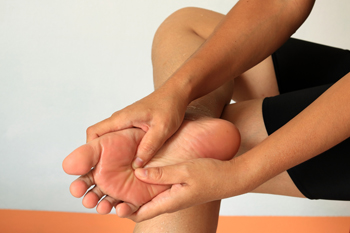 Anyone with rheumatoid arthritis (RA) knows the inflammatory joint pain, stiffness, and swelling that can become a constant factor in their life. About a fifth of people with RA experience this inflammation first in one of the many toes, foot, and ankle joints. As this chronic disease gets worse, it brings with it damage to ligaments and other tissues surrounding the joints. Among the effects are hammertoe, where the middle joint of the toe bends upward; bunions, where the bone on the big toe protrudes as it is displaced; bursitis, where the fluid-filled sacs in a joint become inflamed; and claw toe, where the toe curls under. Because there is no known cure for rheumatoid arthritis, it is especially important to seek the care of a podiatrist who can help to identify the severity of the affected area(s) and begin a course of treatment to reduce the pain through medication, lifestyle changes, and possibly surgery if needed.
Anyone with rheumatoid arthritis (RA) knows the inflammatory joint pain, stiffness, and swelling that can become a constant factor in their life. About a fifth of people with RA experience this inflammation first in one of the many toes, foot, and ankle joints. As this chronic disease gets worse, it brings with it damage to ligaments and other tissues surrounding the joints. Among the effects are hammertoe, where the middle joint of the toe bends upward; bunions, where the bone on the big toe protrudes as it is displaced; bursitis, where the fluid-filled sacs in a joint become inflamed; and claw toe, where the toe curls under. Because there is no known cure for rheumatoid arthritis, it is especially important to seek the care of a podiatrist who can help to identify the severity of the affected area(s) and begin a course of treatment to reduce the pain through medication, lifestyle changes, and possibly surgery if needed.
Because RA affects more than just your joints, including the joints in your feet and ankles, it is important to seek early diagnosis from your podiatrist if you feel like the pain in your feet might be caused by RA. For more information, contact one of our doctors of Favor Foot Ankle Leg & Wound Center. Our doctors will assist you with all of your podiatric concerns.
What Is Rheumatoid Arthritis?
Rheumatoid Arthritis (RA) is an autoimmune disorder in which the body’s own immune system attacks the membranes surrounding the joints. Inflammation of the lining and eventually the destruction of the joint’s cartilage and bone occur, causing severe pain and immobility.
Rheumatoid Arthritis of the Feet
Although RA usually attacks multiple bones and joints throughout the entire body, almost 90 percent of cases result in pain in the foot or ankle area.
Symptoms
- Swelling and pain in the feet
- Stiffness in the feet
- Pain on the ball or sole of feet
- Joint shift and deformation
Diagnosis
Quick diagnosis of RA in the feet is important so that the podiatrist can treat the area effectively. Your doctor will ask you about your medical history, occupation, and lifestyle to determine the origin of the condition. Rheumatoid Factor tests help to determine if someone is affected by the disease.
If you have any questions please feel free to contact our office located in South Amboy, NJ . We offer the newest diagnostic and treatment technologies for all your foot and ankle needs.
What to Do When Your Feet Are Burning
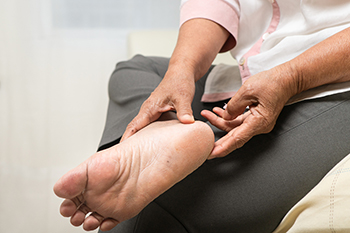 The sensation that your feet are uncomfortably hot and painful is commonly known as BFS, or burning feet syndrome. It is more common in the elderly, and the sensation is especially active at night. BFS can target both the sole and the top of your feet, as well as your ankles and legs. One of the main causes of BFS is diabetes, but others include heavy alcohol use, Charcot-Marie-Tooth disease (damage to peripheral nerves), and tarsal tunnel syndrome (nerve damage in the ankle). Depending on the underlying cause and the seriousness of the ailment, several home remedies may help. Among them are soaking your feet in cold water, in warm water with Epsom salts, or in apple cider vinegar; taking fish oil supplements; massaging with ginger oil; and applying numbing creams or patches to the affected area. A note of caution: If you are experiencing continuous burning feet syndrome, it is a good idea to visit a podiatrist who can assess the severity of your condition and offer further treatment options.
The sensation that your feet are uncomfortably hot and painful is commonly known as BFS, or burning feet syndrome. It is more common in the elderly, and the sensation is especially active at night. BFS can target both the sole and the top of your feet, as well as your ankles and legs. One of the main causes of BFS is diabetes, but others include heavy alcohol use, Charcot-Marie-Tooth disease (damage to peripheral nerves), and tarsal tunnel syndrome (nerve damage in the ankle). Depending on the underlying cause and the seriousness of the ailment, several home remedies may help. Among them are soaking your feet in cold water, in warm water with Epsom salts, or in apple cider vinegar; taking fish oil supplements; massaging with ginger oil; and applying numbing creams or patches to the affected area. A note of caution: If you are experiencing continuous burning feet syndrome, it is a good idea to visit a podiatrist who can assess the severity of your condition and offer further treatment options.
Proper foot care is something many older adults forget to consider. If you have any concerns about your feet and ankles, contact one of our doctors from Favor Foot Ankle Leg & Wound Center. Our doctors can provide the care you need to keep you pain-free and on your feet.
The Elderly and Their Feet
As we age we start to notice many changes in our body, but the elder population may not notice them right away. Medical conditions may prevent the elderly to take notice of their foot health right away. Poor vision is a lead contributor to not taking action for the elderly.
Common Conditions
- Neuropathy – can reduce feeling in the feet and can hide many life-threatening medical conditions.
- Reduced flexibility – prevents the ability of proper toenail trimming, and foot cleaning. If left untreated, it may lead to further medical issues.
- Foot sores – amongst the older population can be serious before they are discovered. Some of the problematic conditions they may face are:
- Gouging toenails affecting nearby toe
- Shoes that don’t fit properly
- Pressure sores
- Loss of circulation in legs & feet
- Edema & swelling of feet and ankles
Susceptible Infections
Diabetes and poor circulation can cause general loss of sensitivity over the years, turning a simple cut into a serious issue.
If you have any questions please feel free to contact our office located in South Amboy, NJ . We offer the newest diagnostic and treatment technologies for all your foot and ankle needs.
Stress Fractures Can Be Caused by Walking
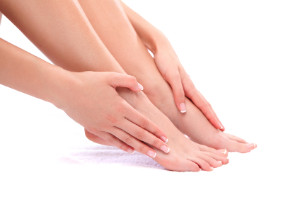 If you feel pain or discomfort in the midfoot area, you may have developed stress fractures in the 2nd and 3rd metatarsal bones of the foot. The most common cause is repetitive walking for long periods. This condition, sometimes called “march fractures,” is common after a trip with prolonged walks or hikes, in overtraining for a marathon type of event, or from military recruitment exercises. Other causes include a change in foot shape—perhaps the result of bunions—that may overload the midfoot bones, and osteoporosis, which is a weakening of the bones as the result of low bone density. Symptoms include pain and swelling, as well as tenderness to the touch, which could worsen if the activity is continued. As with all painful foot conditions, it is a good idea to schedule a visit to a podiatrist for a complete checkup, which will likely include X-rays or other imaging tests to see the extent of the injury. In the meantime, avoid walking or bearing weight on the affected foot as much as possible to help it heal more quickly.
If you feel pain or discomfort in the midfoot area, you may have developed stress fractures in the 2nd and 3rd metatarsal bones of the foot. The most common cause is repetitive walking for long periods. This condition, sometimes called “march fractures,” is common after a trip with prolonged walks or hikes, in overtraining for a marathon type of event, or from military recruitment exercises. Other causes include a change in foot shape—perhaps the result of bunions—that may overload the midfoot bones, and osteoporosis, which is a weakening of the bones as the result of low bone density. Symptoms include pain and swelling, as well as tenderness to the touch, which could worsen if the activity is continued. As with all painful foot conditions, it is a good idea to schedule a visit to a podiatrist for a complete checkup, which will likely include X-rays or other imaging tests to see the extent of the injury. In the meantime, avoid walking or bearing weight on the affected foot as much as possible to help it heal more quickly.
Stress fractures occur when there is a tiny crack within a bone. To learn more, contact one of our doctors from Favor Foot Ankle Leg & Wound Center. Our doctors can provide the care you need to keep you pain free and on your feet.
How Are They Caused?
Stress fractures are the result of repetitive force being placed on the bone. Since the lower leg and feet often carry most of the body’s weight, stress fractures are likely to occur in these areas. If you rush into a new exercise, you are more likely to develop a stress fracture since you are starting too much, too soon. Pain resulting from stress fractures may go unnoticed at first, however it may start to worsen over time.
Risk Factors
- Gender – They are more commonly found in women compared to men.
- Foot Problems – People with unusual arches in their feet are more likely to develop stress fractures.
- Certain Sports – Dancers, gymnasts, tennis players, runners, and basketball players are more likely to develop stress fractures.
- Lack of Nutrients – A lack of vitamin D and calcium may weaken the bones and make you more prone to stress fractures
- Weak Bones – Osteoporosis can weaken the bones therefore resulting in stress fractures
Stress fractures do not always heal properly, so it is important that you seek help from a podiatrist if you suspect you may have one. Ignoring your stress fracture may cause it to worsen, and you may develop chronic pain as well as additional fractures.
If you have any questions, please feel free to contact our office located in South Amboy, NJ . We offer the newest diagnostic and treatment technologies for all your foot care needs.
Blog Archives
- July 2025
- June 2025
- May 2025
- April 2025
- March 2025
- February 2025
- January 2025
- December 2024
- November 2024
- October 2024
- September 2024
- August 2024
- July 2024
- June 2024
- May 2024
- April 2024
- March 2024
- February 2024
- January 2024
- December 2023
- November 2023
- October 2023
- September 2023
- August 2023
- July 2023
- June 2023
- May 2023
- April 2023
- March 2023
- February 2023
- January 2023
- December 2022
- November 2022
- October 2022
- September 2022
- August 2022
- July 2022
- June 2022
- May 2022
- April 2022
- March 2022
- February 2022
- January 2022
- December 2021
- November 2021
- October 2021
- September 2021
- August 2021
- July 2021
- June 2021
- May 2021
- April 2021
- March 2021
- February 2021
